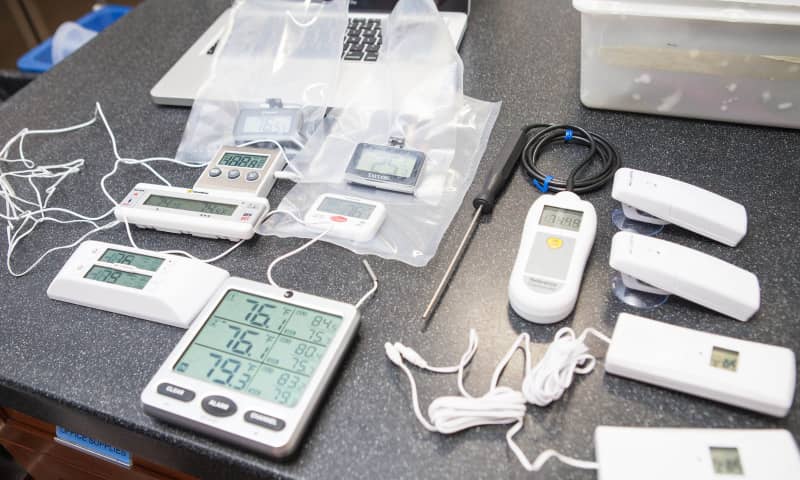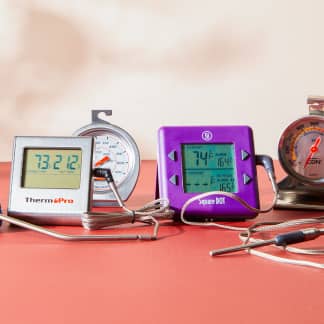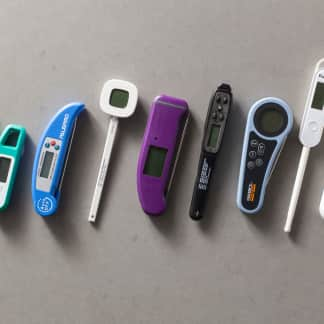To make sure our refrigerators and freezers consistently operate at the optimal levels for food safety (at or below 40 degrees for refrigerators and zero degrees for freezers), we like to use special thermometers designed to track their temperatures over time. Simple instant-read refrigerator/freezer thermometers only tell you the current temperature of your appliance; they won’t necessarily let you know if your refrigerator or freezer veers out of the safe zone when you aren’t looking. So we narrowed our testing to include only digital refrigerator and freezer thermometers that have alarms—audio and/or visual indicators to alert you if the temperature has gone off course. We bought four thermometers and set out to find the best model—one that was accurate, was easy to read and use, and would do a good job of alerting us if temperatures went into the danger zone.
All of the models had at least two parts: a display that mounts magnetically on the outside of the refrigerator or sits on the counter, and a temperature sensor that goes inside the refrigerator and relays temperatures to the display. One model was wireless, but its temperature sensors were embedded in large cases that hogged valuable space in the refrigerator and freezer. We preferred models whose sensors were attached to wire probes that snaked from the display or monitor to the refrigerator or freezer—the wires were unobtrusive and easy to position anywhere in the refrigerator. (Don’t worry—your refrigerator or freezer will still seal tightly with the wires running inside, as the wires are quite thin.)

We also preferred models that came with two sensors, which allowed us to monitor refrigerator and freezer temperatures simultaneously. All thermometers allowed users to track both the maximum and minimum temperatures measured and to set audio and/or visual alerts to go off when temperatures went above or below customizable points (while alert styles varied, all models continued to indicate that the temperature had gone out of range until the user reset the alarm). In general, we liked models that were intuitive to navigate and program and had large, easy-to-read displays that made it clear when we were looking at current temperatures and when we were looking at maximums or minimums. Some users preferred visual alerts, and some preferred audio. Options differ from model to model; our favorite allows users to choose either or both.
All the models were reasonably accurate when placed in an ice bath and when used in the refrigerator, living up to their manufacturers’ claims to measure temperatures within 2 degrees of those recorded by a lab-grade thermocouple. In the freezer, however, two of the models faltered a bit, recording temperatures that were off from the thermocouple’s readings by an average of 2 to almost 4 degrees; while small fluctuations like these won’t normally be a problem, we preferred models that recorded temperatures that were as close as possible to those registered by the thermocouple.

Our winner, the ThermoWorks Fridge/Freezer Alarm, was the most accurate thermometer in our testing. It had two probes and a clear, though relatively small, display. Its interface was a little tricky to navigate, but an extra feature more than made up for this minor flaw: This unit not only alerts you when temperatures go above or below the temperatures you designate, but when temperatures remain outside those points for more than a half-hour, the thermometer tracks the duration of that infraction, letting you know exactly how long your food has been out of the target zone. Finally, this thermometer is durable: To simulate a year’s use, we installed it in a refrigerator and then opened and closed the door 1,000 times. Afterward, the wire probes were good as new and registered the ice melting point as accurately as they had the first time.
The Tests
- Test accuracy in ice bath (versus lab-grade thermocouple)
- Install in refrigerator and/or freezer; program refrigerator alarms to go off at temperatures above 40ºF and freezer alarms to go off above 0ºF
- Test accuracy in refrigerator (versus lab-grade thermocouple)
- Test accuracy in freezer (versus lab-grade thermocouple)
- Test alarm function
- Install winning thermometer in refrigerator; open and close refrigerator door 1,000 times and retest accuracy in ice bath (versus lab-grade thermocouple)
How We Rated
- Accuracy: We gave more points to thermometers that registered temperatures closest to those recorded by our reference thermometer.
- Ease of Use: We awarded more points to thermometers that had two sensors, took up little space in our refrigerators and freezers, and were easy to install, navigate, and program.
- Display: We awarded more points to models with bold, easy-to read displays that clearly indicated current, maximum, and minimum temperatures.
- Highly accurate
- Includes two sensors
- Clear display


 Buy at ThermoWorks
Buy at ThermoWorks





